child lock BMW M5 SEDAN 2013 Owners Manual
[x] Cancel search | Manufacturer: BMW, Model Year: 2013, Model line: M5 SEDAN, Model: BMW M5 SEDAN 2013Pages: 230, PDF Size: 6.29 MB
Page 47 of 230
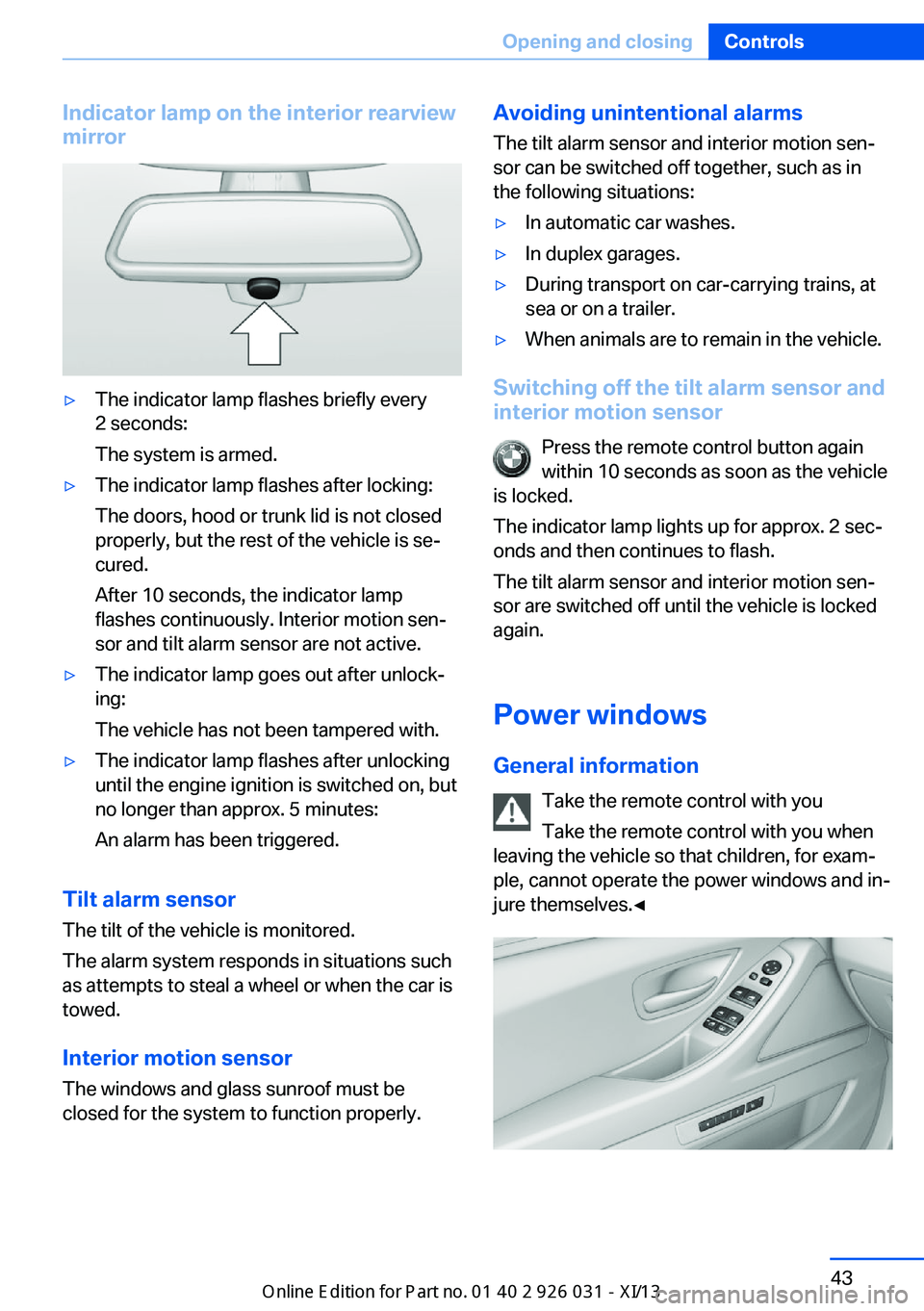
Indicator lamp on the interior rearview
mirror▷The indicator lamp flashes briefly every
2 seconds:
The system is armed.▷The indicator lamp flashes after locking:
The doors, hood or trunk lid is not closed
properly, but the rest of the vehicle is se‐
cured.
After 10 seconds, the indicator lamp
flashes continuously. Interior motion sen‐
sor and tilt alarm sensor are not active.▷The indicator lamp goes out after unlock‐
ing:
The vehicle has not been tampered with.▷The indicator lamp flashes after unlocking
until the engine ignition is switched on, but
no longer than approx. 5 minutes:
An alarm has been triggered.
Tilt alarm sensor The tilt of the vehicle is monitored.
The alarm system responds in situations such
as attempts to steal a wheel or when the car is
towed.
Interior motion sensor The windows and glass sunroof must be
closed for the system to function properly.
Avoiding unintentional alarms
The tilt alarm sensor and interior motion sen‐
sor can be switched off together, such as in
the following situations:▷In automatic car washes.▷In duplex garages.▷During transport on car-carrying trains, at
sea or on a trailer.▷When animals are to remain in the vehicle.
Switching off the tilt alarm sensor and
interior motion sensor
Press the remote control button again
within 10 seconds as soon as the vehicle
is locked.
The indicator lamp lights up for approx. 2 sec‐
onds and then continues to flash.
The tilt alarm sensor and interior motion sen‐
sor are switched off until the vehicle is locked
again.
Power windows
General information Take the remote control with you
Take the remote control with you when
leaving the vehicle so that children, for exam‐
ple, cannot operate the power windows and in‐
jure themselves.◀
Seite 43Opening and closingControls43
Online Edition for Part no. 01 40 2 909 953 - VI/13
Page 49 of 230
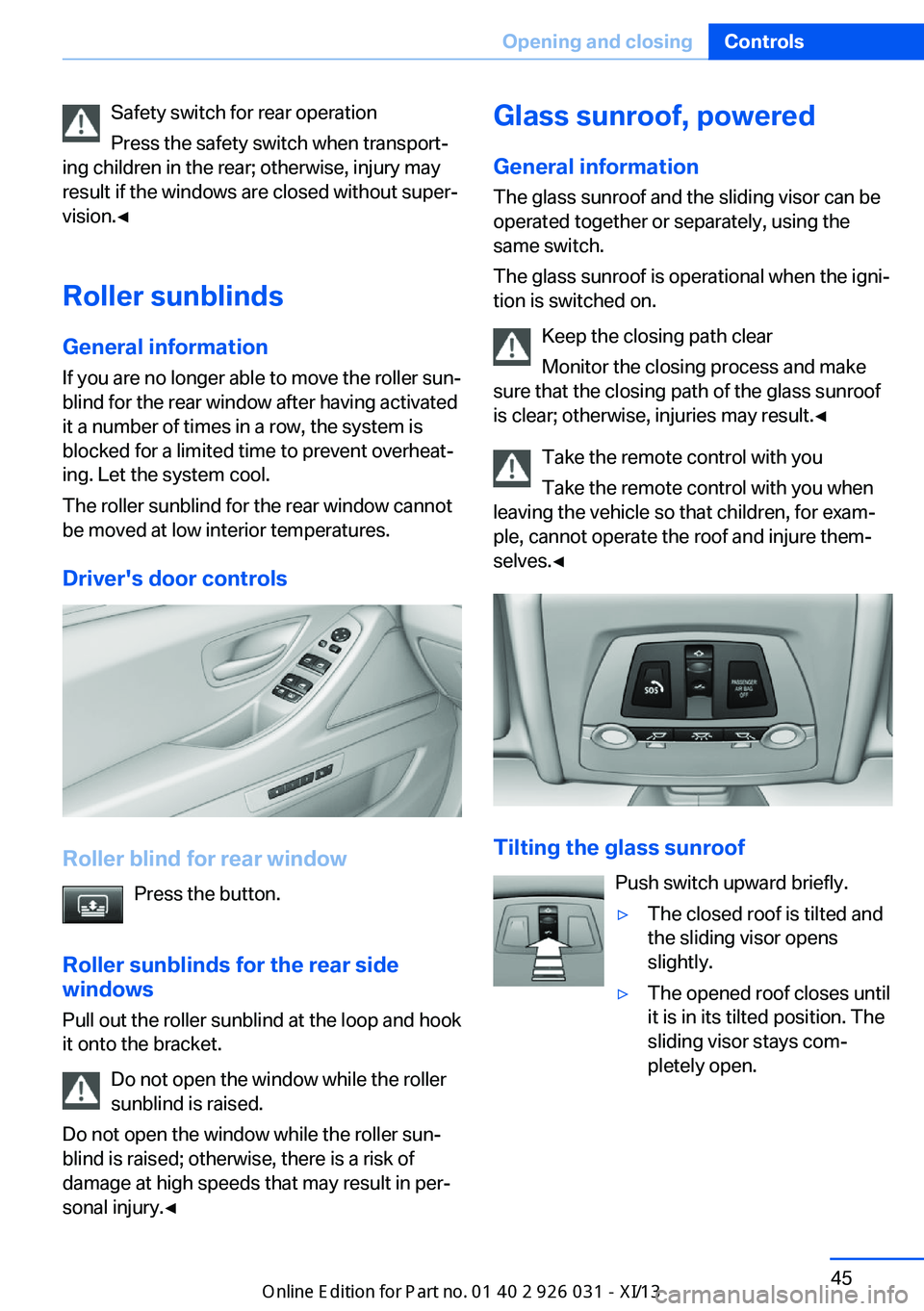
Safety switch for rear operation
Press the safety switch when transport‐
ing children in the rear; otherwise, injury may
result if the windows are closed without super‐
vision.◀
Roller sunblinds
General information If you are no longer able to move the roller sun‐
blind for the rear window after having activated
it a number of times in a row, the system is
blocked for a limited time to prevent overheat‐
ing. Let the system cool.
The roller sunblind for the rear window cannot
be moved at low interior temperatures.
Driver's door controls
Roller blind for rear window Press the button.
Roller sunblinds for the rear side windows
Pull out the roller sunblind at the loop and hook
it onto the bracket.
Do not open the window while the roller
sunblind is raised.
Do not open the window while the roller sun‐
blind is raised; otherwise, there is a risk of
damage at high speeds that may result in per‐
sonal injury.◀
Glass sunroof, powered
General information
The glass sunroof and the sliding visor can be
operated together or separately, using the
same switch.
The glass sunroof is operational when the igni‐
tion is switched on.
Keep the closing path clear
Monitor the closing process and make
sure that the closing path of the glass sunroof
is clear; otherwise, injuries may result.◀
Take the remote control with youTake the remote control with you when
leaving the vehicle so that children, for exam‐
ple, cannot operate the roof and injure them‐
selves.◀
Tilting the glass sunroof
Push switch upward briefly.
▷The closed roof is tilted and
the sliding visor opens
slightly.▷The opened roof closes until
it is in its tilted position. The
sliding visor stays com‐
pletely open.Seite 45Opening and closingControls45
Online Edition for Part no. 01 40 2 909 953 - VI/13
Page 63 of 230
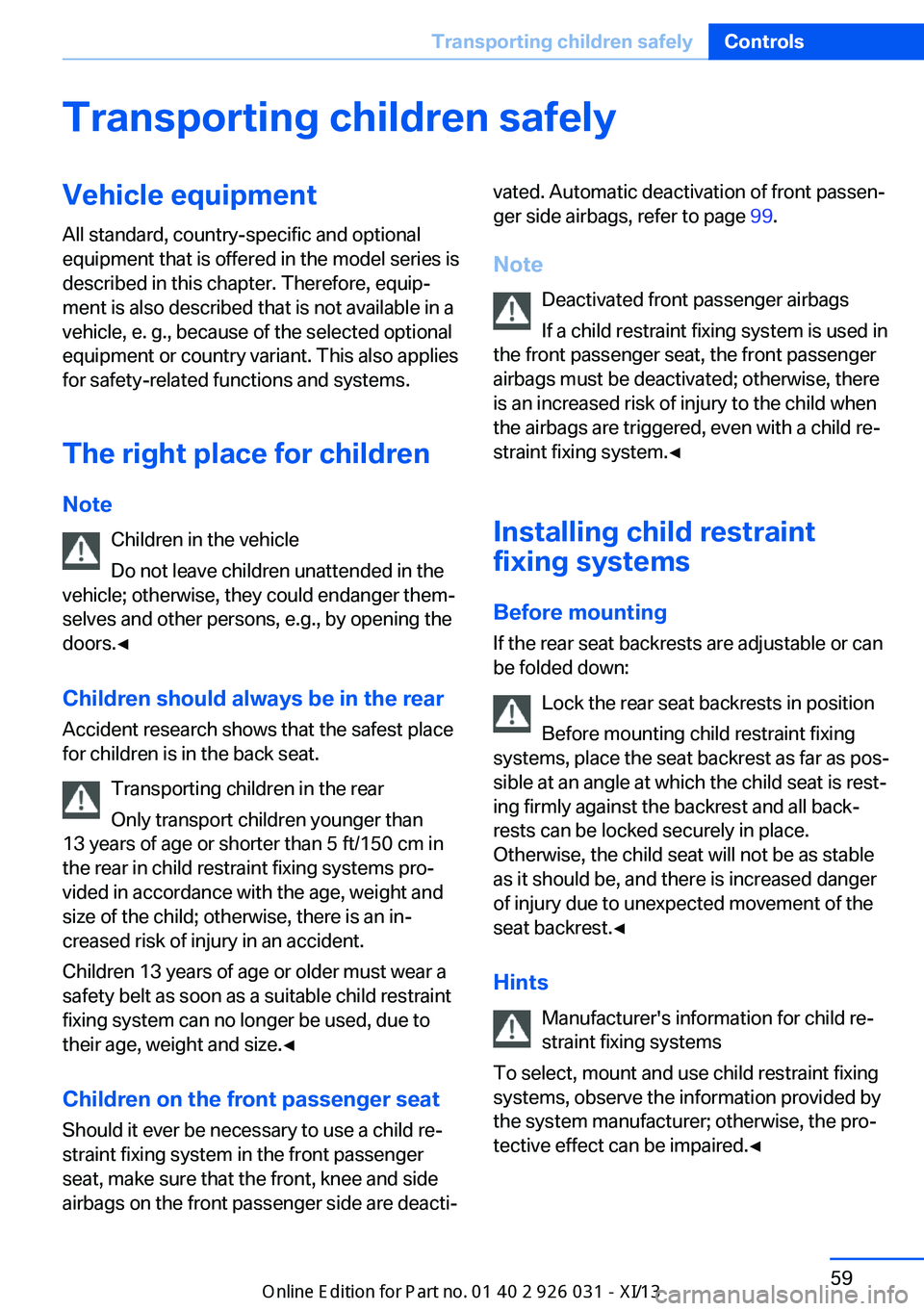
Transporting children safelyVehicle equipmentAll standard, country-specific and optional
equipment that is offered in the model series is
described in this chapter. Therefore, equip‐
ment is also described that is not available in a
vehicle, e. g., because of the selected optional
equipment or country variant. This also applies
for safety-related functions and systems.
The right place for children Note Children in the vehicle
Do not leave children unattended in the
vehicle; otherwise, they could endanger them‐
selves and other persons, e.g., by opening the
doors.◀
Children should always be in the rear
Accident research shows that the safest place
for children is in the back seat.
Transporting children in the rear
Only transport children younger than
13 years of age or shorter than 5 ft/150 cm in
the rear in child restraint fixing systems pro‐
vided in accordance with the age, weight and
size of the child; otherwise, there is an in‐
creased risk of injury in an accident.
Children 13 years of age or older must wear a
safety belt as soon as a suitable child restraint
fixing system can no longer be used, due to
their age, weight and size.◀
Children on the front passenger seat
Should it ever be necessary to use a child re‐
straint fixing system in the front passenger
seat, make sure that the front, knee and side
airbags on the front passenger side are deacti‐vated. Automatic deactivation of front passen‐
ger side airbags, refer to page 99.
Note Deactivated front passenger airbags
If a child restraint fixing system is used in
the front passenger seat, the front passenger
airbags must be deactivated; otherwise, there
is an increased risk of injury to the child when
the airbags are triggered, even with a child re‐
straint fixing system.◀
Installing child restraint
fixing systems
Before mounting
If the rear seat backrests are adjustable or can
be folded down:
Lock the rear seat backrests in position
Before mounting child restraint fixing
systems, place the seat backrest as far as pos‐
sible at an angle at which the child seat is rest‐
ing firmly against the backrest and all back‐
rests can be locked securely in place.
Otherwise, the child seat will not be as stable
as it should be, and there is increased danger
of injury due to unexpected movement of the
seat backrest.◀
Hints Manufacturer's information for child re‐
straint fixing systems
To select, mount and use child restraint fixing
systems, observe the information provided by
the system manufacturer; otherwise, the pro‐
tective effect can be impaired.◀Seite 59Transporting children safelyControls59
Online Edition for Part no. 01 40 2 909 953 - VI/13
Page 64 of 230
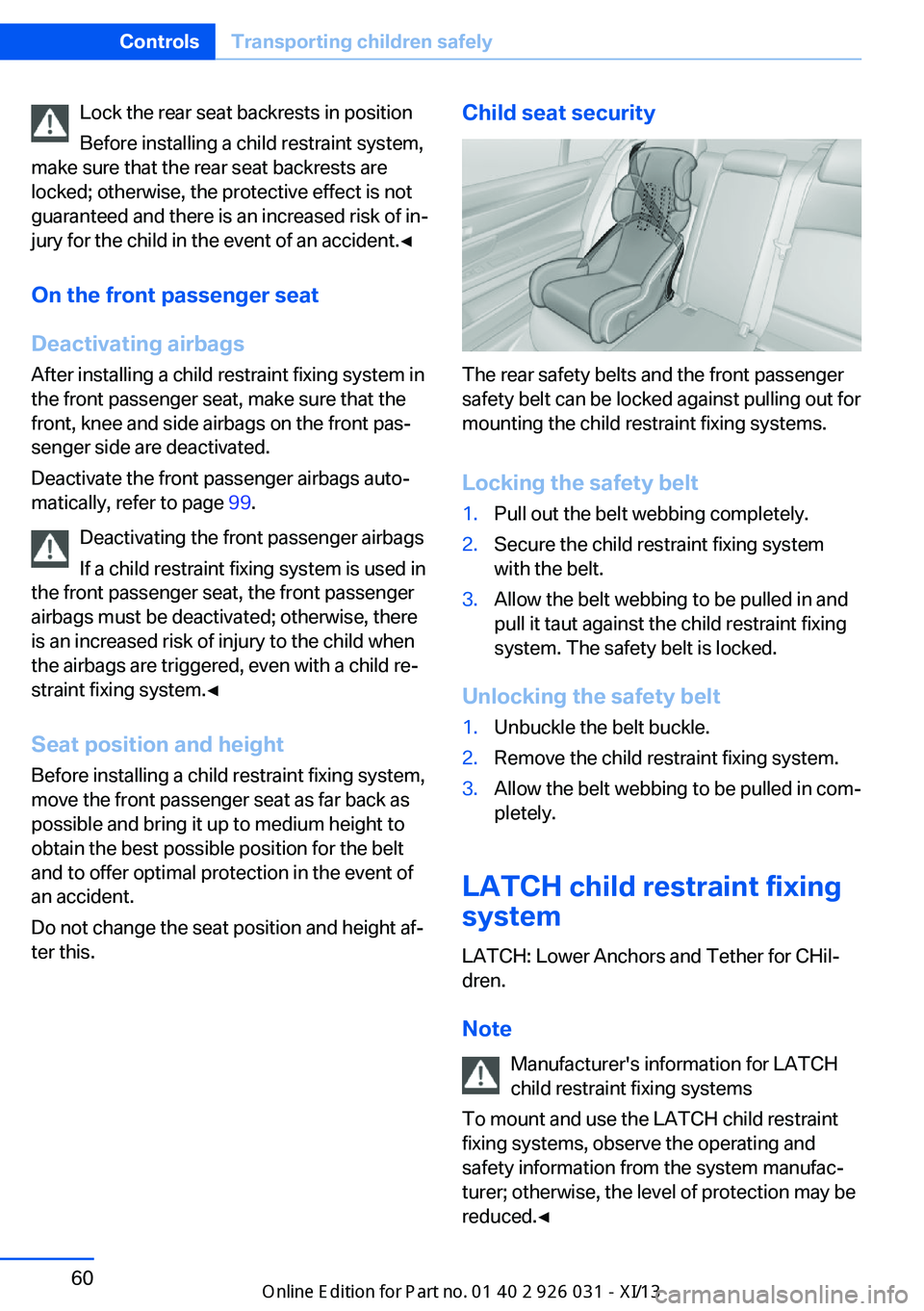
Lock the rear seat backrests in position
Before installing a child restraint system,
make sure that the rear seat backrests are
locked; otherwise, the protective effect is not
guaranteed and there is an increased risk of in‐
jury for the child in the event of an accident.◀
On the front passenger seat
Deactivating airbags
After installing a child restraint fixing system in
the front passenger seat, make sure that the
front, knee and side airbags on the front pas‐
senger side are deactivated.
Deactivate the front passenger airbags auto‐
matically, refer to page 99.
Deactivating the front passenger airbags
If a child restraint fixing system is used in
the front passenger seat, the front passenger
airbags must be deactivated; otherwise, there
is an increased risk of injury to the child when
the airbags are triggered, even with a child re‐
straint fixing system.◀
Seat position and height
Before installing a child restraint fixing system,
move the front passenger seat as far back as
possible and bring it up to medium height to
obtain the best possible position for the belt
and to offer optimal protection in the event of
an accident.
Do not change the seat position and height af‐
ter this.Child seat security
The rear safety belts and the front passenger
safety belt can be locked against pulling out for
mounting the child restraint fixing systems.
Locking the safety belt
1.Pull out the belt webbing completely.2.Secure the child restraint fixing system
with the belt.3.Allow the belt webbing to be pulled in and
pull it taut against the child restraint fixing
system. The safety belt is locked.
Unlocking the safety belt
1.Unbuckle the belt buckle.2.Remove the child restraint fixing system.3.Allow the belt webbing to be pulled in com‐
pletely.
LATCH child restraint fixing
system
LATCH: Lower Anchors and Tether for CHil‐dren.
Note Manufacturer's information for LATCH
child restraint fixing systems
To mount and use the LATCH child restraint
fixing systems, observe the operating and
safety information from the system manufac‐
turer; otherwise, the level of protection may be
reduced.◀
Seite 60ControlsTransporting children safely60
Online Edition for Part no. 01 40 2 909 953 - VI/13
Page 66 of 230
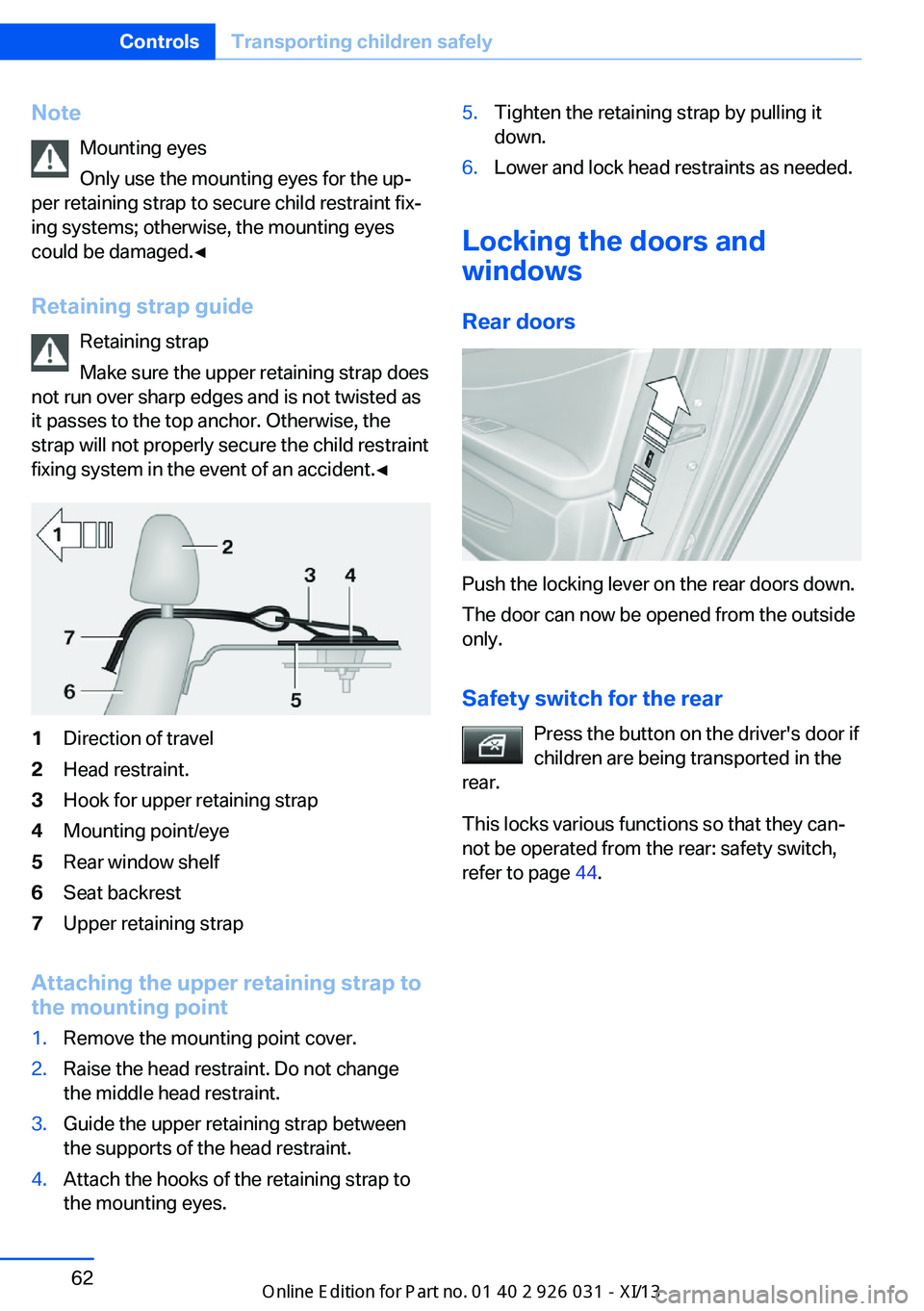
NoteMounting eyes
Only use the mounting eyes for the up‐
per retaining strap to secure child restraint fix‐
ing systems; otherwise, the mounting eyes
could be damaged.◀
Retaining strap guide Retaining strap
Make sure the upper retaining strap does
not run over sharp edges and is not twisted as
it passes to the top anchor. Otherwise, the
strap will not properly secure the child restraint
fixing system in the event of an accident.◀1Direction of travel2Head restraint.3Hook for upper retaining strap4Mounting point/eye5Rear window shelf6Seat backrest7Upper retaining strap
Attaching the upper retaining strap to
the mounting point
1.Remove the mounting point cover.2.Raise the head restraint. Do not change
the middle head restraint.3.Guide the upper retaining strap between
the supports of the head restraint.4.Attach the hooks of the retaining strap to
the mounting eyes.5.Tighten the retaining strap by pulling it
down.6.Lower and lock head restraints as needed.
Locking the doors and
windows
Rear doors
Push the locking lever on the rear doors down.
The door can now be opened from the outside
only.
Safety switch for the rear Press the button on the driver's door if
children are being transported in the
rear.
This locks various functions so that they can‐
not be operated from the rear: safety switch,
refer to page 44.
Seite 62ControlsTransporting children safely62
Online Edition for Part no. 01 40 2 909 953 - VI/13
Page 151 of 230
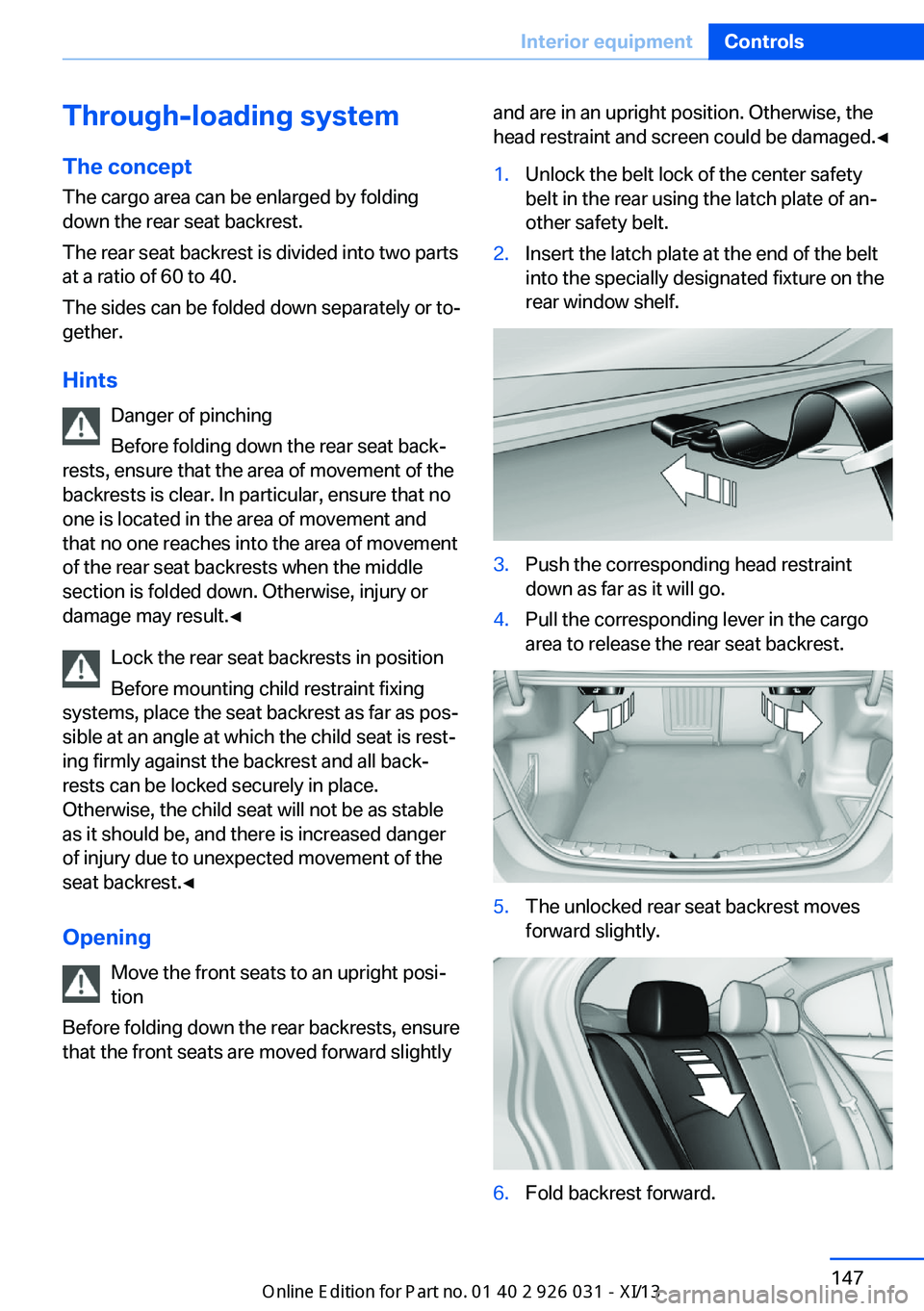
Through-loading systemThe concept The cargo area can be enlarged by folding
down the rear seat backrest.
The rear seat backrest is divided into two parts at a ratio of 60 to 40.
The sides can be folded down separately or to‐
gether.
Hints Danger of pinching
Before folding down the rear seat back‐
rests, ensure that the area of movement of the
backrests is clear. In particular, ensure that no
one is located in the area of movement and
that no one reaches into the area of movement
of the rear seat backrests when the middle
section is folded down. Otherwise, injury or
damage may result.◀
Lock the rear seat backrests in position
Before mounting child restraint fixing
systems, place the seat backrest as far as pos‐
sible at an angle at which the child seat is rest‐
ing firmly against the backrest and all back‐
rests can be locked securely in place.
Otherwise, the child seat will not be as stable
as it should be, and there is increased danger
of injury due to unexpected movement of the
seat backrest.◀
Opening Move the front seats to an upright posi‐
tion
Before folding down the rear backrests, ensure
that the front seats are moved forward slightlyand are in an upright position. Otherwise, the
head restraint and screen could be damaged.◀1.Unlock the belt lock of the center safety
belt in the rear using the latch plate of an‐
other safety belt.2.Insert the latch plate at the end of the belt
into the specially designated fixture on the
rear window shelf.3.Push the corresponding head restraint
down as far as it will go.4.Pull the corresponding lever in the cargo
area to release the rear seat backrest.5.The unlocked rear seat backrest moves
forward slightly.6.Fold backrest forward.Seite 147Interior equipmentControls147
Online Edition for Part no. 01 40 2 909 953 - VI/13
Page 221 of 230
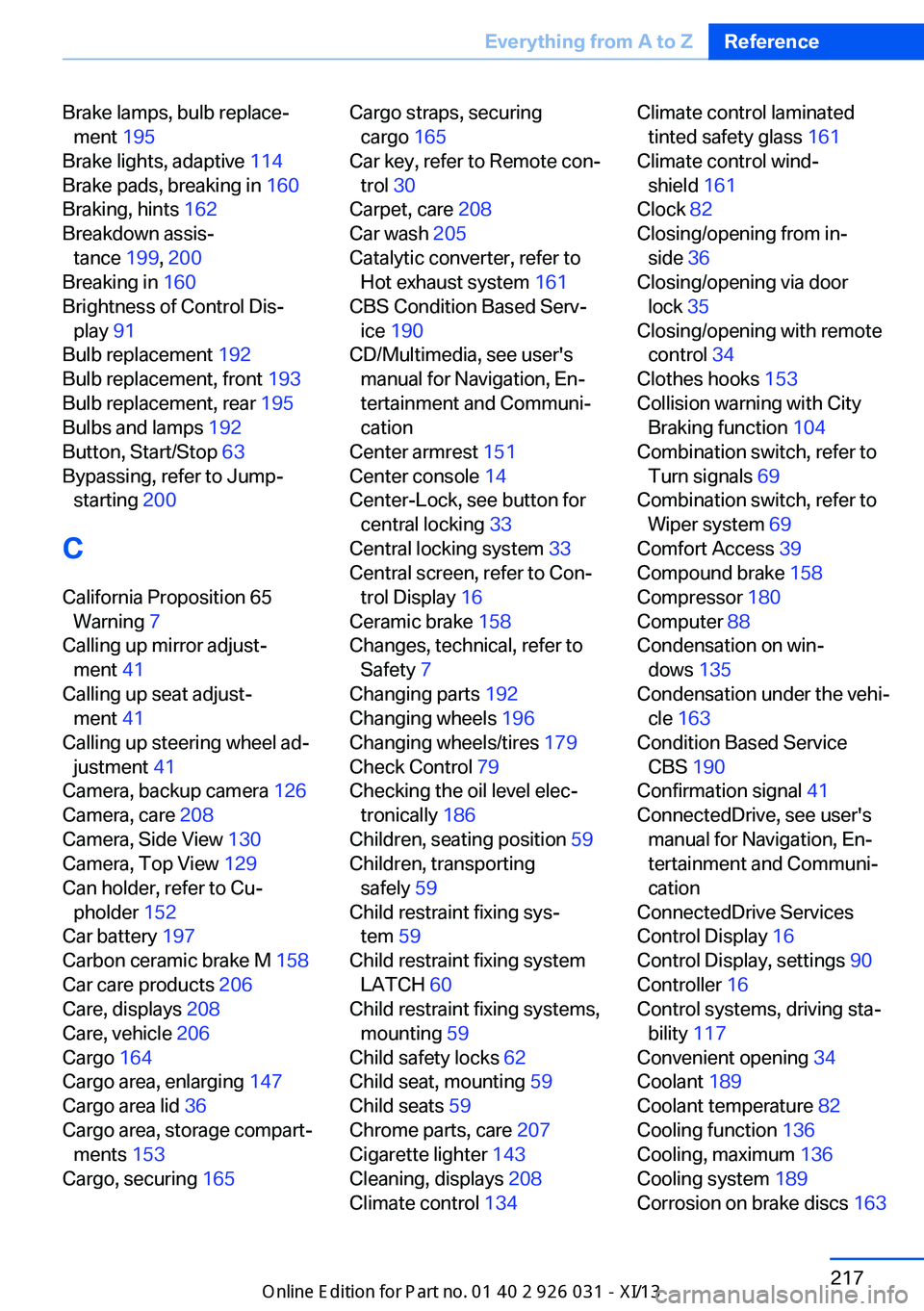
Brake lamps, bulb replace‐ment 195
Brake lights, adaptive 114
Brake pads, breaking in 160
Braking, hints 162
Breakdown assis‐ tance 199, 200
Breaking in 160
Brightness of Control Dis‐ play 91
Bulb replacement 192
Bulb replacement, front 193
Bulb replacement, rear 195
Bulbs and lamps 192
Button, Start/Stop 63
Bypassing, refer to Jump- starting 200
C
California Proposition 65 Warning 7
Calling up mirror adjust‐ ment 41
Calling up seat adjust‐ ment 41
Calling up steering wheel ad‐ justment 41
Camera, backup camera 126
Camera, care 208
Camera, Side View 130
Camera, Top View 129
Can holder, refer to Cu‐ pholder 152
Car battery 197
Carbon ceramic brake M 158
Car care products 206
Care, displays 208
Care, vehicle 206
Cargo 164
Cargo area, enlarging 147
Cargo area lid 36
Cargo area, storage compart‐ ments 153
Cargo, securing 165 Cargo straps, securing
cargo 165
Car key, refer to Remote con‐ trol 30
Carpet, care 208
Car wash 205
Catalytic converter, refer to Hot exhaust system 161
CBS Condition Based Serv‐ ice 190
CD/Multimedia, see user's manual for Navigation, En‐
tertainment and Communi‐
cation
Center armrest 151
Center console 14
Center-Lock, see button for central locking 33
Central locking system 33
Central screen, refer to Con‐ trol Display 16
Ceramic brake 158
Changes, technical, refer to Safety 7
Changing parts 192
Changing wheels 196
Changing wheels/tires 179
Check Control 79
Checking the oil level elec‐ tronically 186
Children, seating position 59
Children, transporting safely 59
Child restraint fixing sys‐ tem 59
Child restraint fixing system LATCH 60
Child restraint fixing systems, mounting 59
Child safety locks 62
Child seat, mounting 59
Child seats 59
Chrome parts, care 207
Cigarette lighter 143
Cleaning, displays 208
Climate control 134 Climate control laminated
tinted safety glass 161
Climate control wind‐ shield 161
Clock 82
Closing/opening from in‐ side 36
Closing/opening via door lock 35
Closing/opening with remote control 34
Clothes hooks 153
Collision warning with City Braking function 104
Combination switch, refer to Turn signals 69
Combination switch, refer to Wiper system 69
Comfort Access 39
Compound brake 158
Compressor 180
Computer 88
Condensation on win‐ dows 135
Condensation under the vehi‐ cle 163
Condition Based Service CBS 190
Confirmation signal 41
ConnectedDrive, see user's manual for Navigation, En‐
tertainment and Communi‐
cation
ConnectedDrive Services
Control Display 16
Control Display, settings 90
Controller 16
Control systems, driving sta‐ bility 117
Convenient opening 34
Coolant 189
Coolant temperature 82
Cooling function 136
Cooling, maximum 136
Cooling system 189
Corrosion on brake discs 163 Seite 217Everything from A to ZReference217
Online Edition for Part no. 01 40 2 909 953 - VI/13
Page 224 of 230
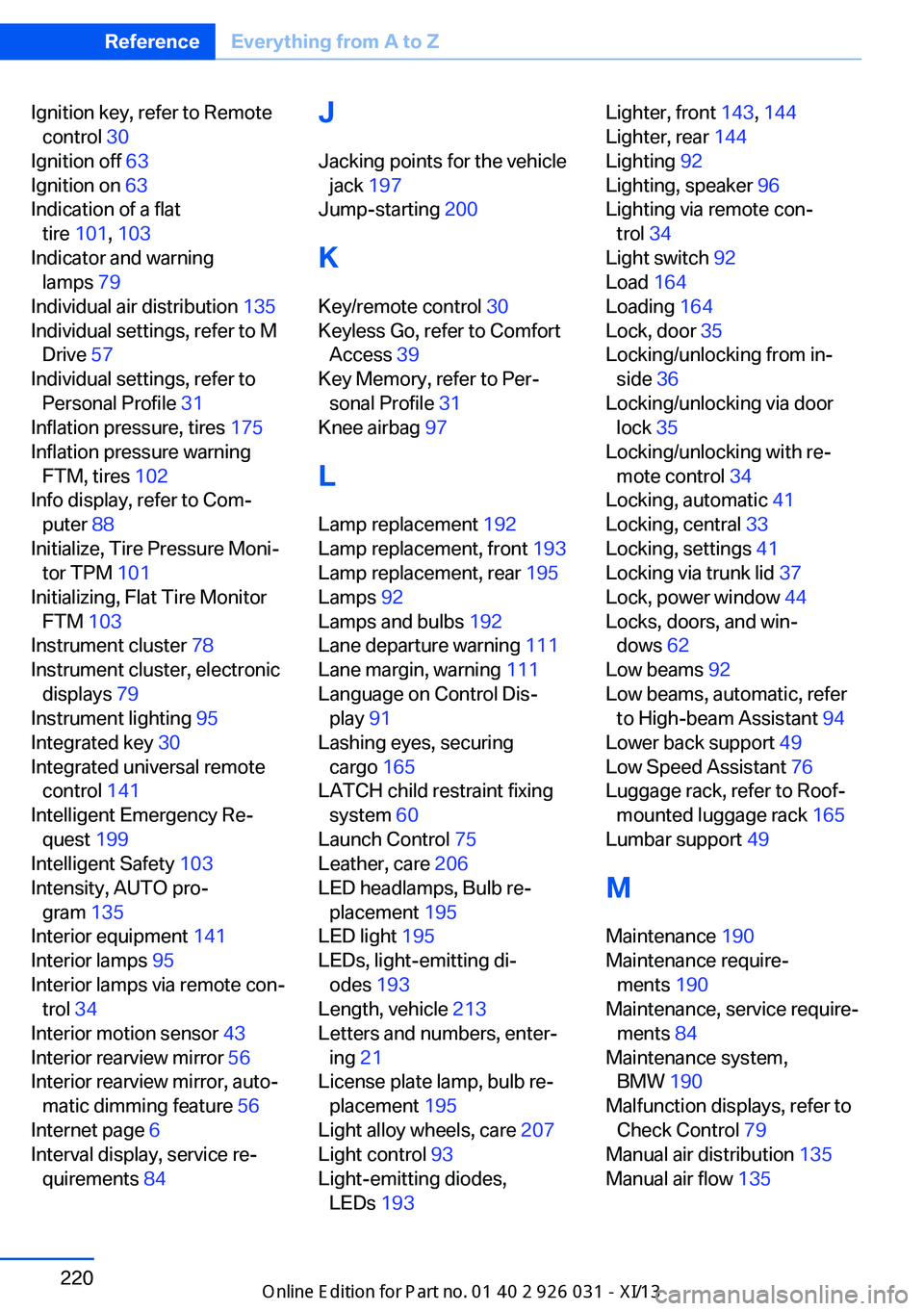
Ignition key, refer to Remotecontrol 30
Ignition off 63
Ignition on 63
Indication of a flat tire 101 , 103
Indicator and warning lamps 79
Individual air distribution 135
Individual settings, refer to M Drive 57
Individual settings, refer to Personal Profile 31
Inflation pressure, tires 175
Inflation pressure warning FTM, tires 102
Info display, refer to Com‐ puter 88
Initialize, Tire Pressure Moni‐ tor TPM 101
Initializing, Flat Tire Monitor FTM 103
Instrument cluster 78
Instrument cluster, electronic displays 79
Instrument lighting 95
Integrated key 30
Integrated universal remote control 141
Intelligent Emergency Re‐ quest 199
Intelligent Safety 103
Intensity, AUTO pro‐ gram 135
Interior equipment 141
Interior lamps 95
Interior lamps via remote con‐ trol 34
Interior motion sensor 43
Interior rearview mirror 56
Interior rearview mirror, auto‐ matic dimming feature 56
Internet page 6
Interval display, service re‐ quirements 84 J
Jacking points for the vehicle jack 197
Jump-starting 200
K
Key/remote control 30
Keyless Go, refer to Comfort Access 39
Key Memory, refer to Per‐ sonal Profile 31
Knee airbag 97
L Lamp replacement 192
Lamp replacement, front 193
Lamp replacement, rear 195
Lamps 92
Lamps and bulbs 192
Lane departure warning 111
Lane margin, warning 111
Language on Control Dis‐ play 91
Lashing eyes, securing cargo 165
LATCH child restraint fixing system 60
Launch Control 75
Leather, care 206
LED headlamps, Bulb re‐ placement 195
LED light 195
LEDs, light-emitting di‐ odes 193
Length, vehicle 213
Letters and numbers, enter‐ ing 21
License plate lamp, bulb re‐ placement 195
Light alloy wheels, care 207
Light control 93
Light-emitting diodes, LEDs 193 Lighter, front 143, 144
Lighter, rear 144
Lighting 92
Lighting, speaker 96
Lighting via remote con‐ trol 34
Light switch 92
Load 164
Loading 164
Lock, door 35
Locking/unlocking from in‐ side 36
Locking/unlocking via door lock 35
Locking/unlocking with re‐ mote control 34
Locking, automatic 41
Locking, central 33
Locking, settings 41
Locking via trunk lid 37
Lock, power window 44
Locks, doors, and win‐ dows 62
Low beams 92
Low beams, automatic, refer to High-beam Assistant 94
Lower back support 49
Low Speed Assistant 76
Luggage rack, refer to Roof- mounted luggage rack 165
Lumbar support 49
M
Maintenance 190
Maintenance require‐ ments 190
Maintenance, service require‐ ments 84
Maintenance system, BMW 190
Malfunction displays, refer to Check Control 79
Manual air distribution 135
Manual air flow 135 Seite 220ReferenceEverything from A to Z220
Online Edition for Part no. 01 40 2 909 953 - VI/13
Page 225 of 230
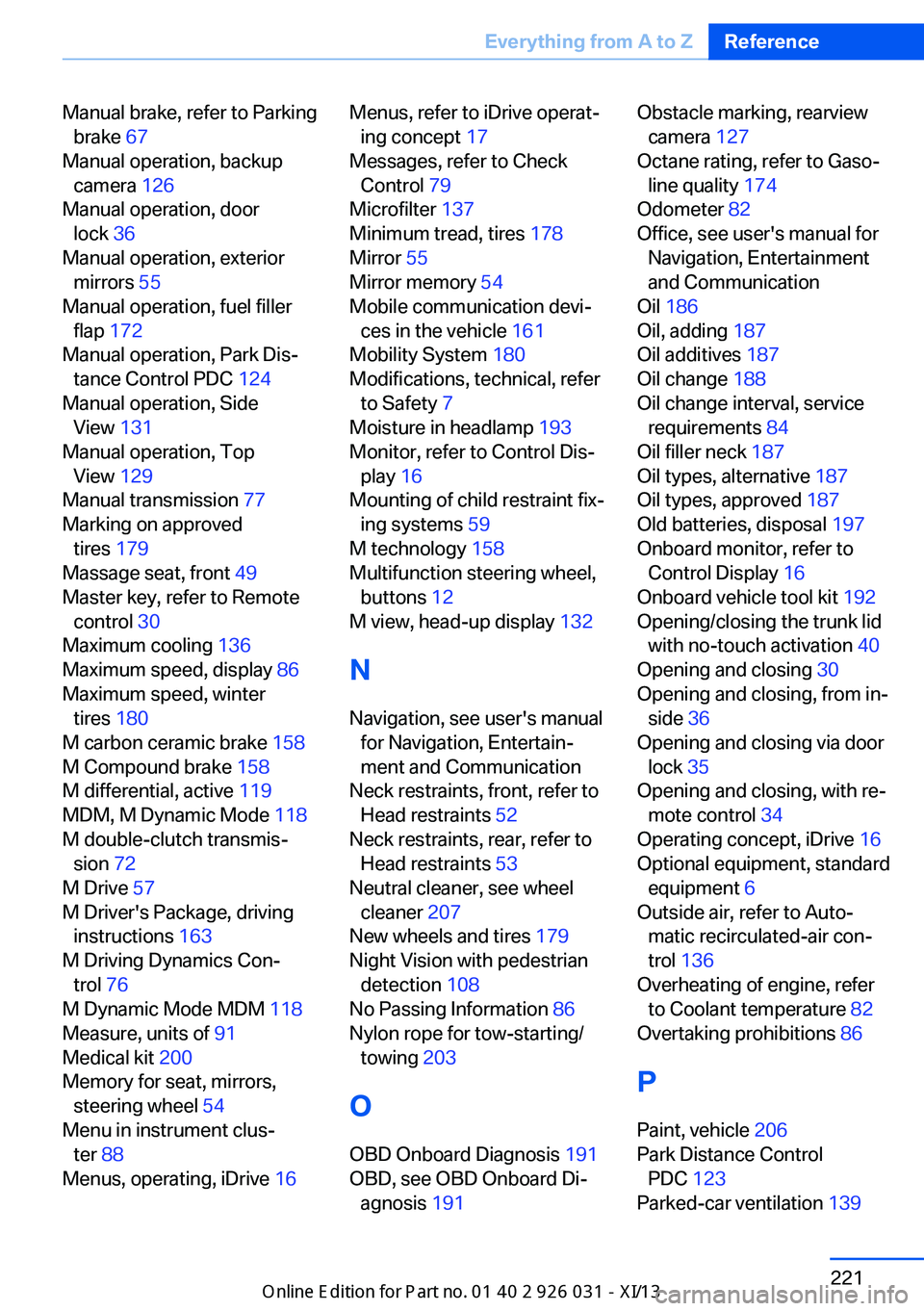
Manual brake, refer to Parkingbrake 67
Manual operation, backup camera 126
Manual operation, door lock 36
Manual operation, exterior mirrors 55
Manual operation, fuel filler flap 172
Manual operation, Park Dis‐ tance Control PDC 124
Manual operation, Side View 131
Manual operation, Top View 129
Manual transmission 77
Marking on approved tires 179
Massage seat, front 49
Master key, refer to Remote control 30
Maximum cooling 136
Maximum speed, display 86
Maximum speed, winter tires 180
M carbon ceramic brake 158
M Compound brake 158
M differential, active 119
MDM, M Dynamic Mode 118
M double-clutch transmis‐ sion 72
M Drive 57
M Driver's Package, driving instructions 163
M Driving Dynamics Con‐ trol 76
M Dynamic Mode MDM 118
Measure, units of 91
Medical kit 200
Memory for seat, mirrors, steering wheel 54
Menu in instrument clus‐ ter 88
Menus, operating, iDrive 16 Menus, refer to iDrive operat‐
ing concept 17
Messages, refer to Check Control 79
Microfilter 137
Minimum tread, tires 178
Mirror 55
Mirror memory 54
Mobile communication devi‐ ces in the vehicle 161
Mobility System 180
Modifications, technical, refer to Safety 7
Moisture in headlamp 193
Monitor, refer to Control Dis‐ play 16
Mounting of child restraint fix‐ ing systems 59
M technology 158
Multifunction steering wheel, buttons 12
M view, head-up display 132
N
Navigation, see user's manual for Navigation, Entertain‐
ment and Communication
Neck restraints, front, refer to Head restraints 52
Neck restraints, rear, refer to Head restraints 53
Neutral cleaner, see wheel cleaner 207
New wheels and tires 179
Night Vision with pedestrian detection 108
No Passing Information 86
Nylon rope for tow-starting/ towing 203
O OBD Onboard Diagnosis 191
OBD, see OBD Onboard Di‐ agnosis 191 Obstacle marking, rearview
camera 127
Octane rating, refer to Gaso‐ line quality 174
Odometer 82
Office, see user's manual for Navigation, Entertainment
and Communication
Oil 186
Oil, adding 187
Oil additives 187
Oil change 188
Oil change interval, service requirements 84
Oil filler neck 187
Oil types, alternative 187
Oil types, approved 187
Old batteries, disposal 197
Onboard monitor, refer to Control Display 16
Onboard vehicle tool kit 192
Opening/closing the trunk lid with no-touch activation 40
Opening and closing 30
Opening and closing, from in‐ side 36
Opening and closing via door lock 35
Opening and closing, with re‐ mote control 34
Operating concept, iDrive 16
Optional equipment, standard equipment 6
Outside air, refer to Auto‐ matic recirculated-air con‐
trol 136
Overheating of engine, refer to Coolant temperature 82
Overtaking prohibitions 86
P Paint, vehicle 206
Park Distance Control PDC 123
Parked-car ventilation 139 Seite 221Everything from A to ZReference221
Online Edition for Part no. 01 40 2 909 953 - VI/13
Page 228 of 230
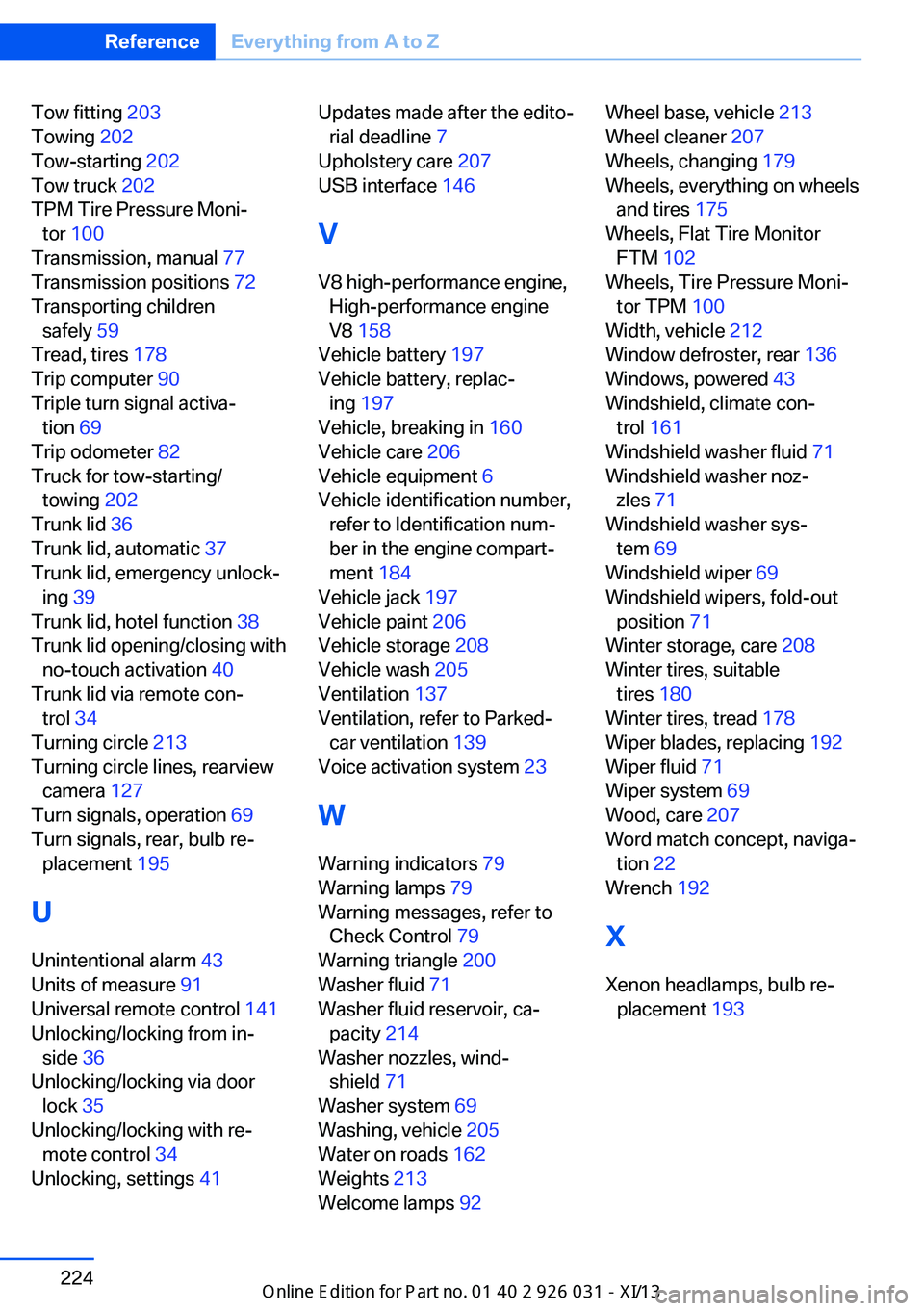
Tow fitting 203
Towing 202
Tow-starting 202
Tow truck 202
TPM Tire Pressure Moni‐ tor 100
Transmission, manual 77
Transmission positions 72
Transporting children safely 59
Tread, tires 178
Trip computer 90
Triple turn signal activa‐ tion 69
Trip odometer 82
Truck for tow-starting/ towing 202
Trunk lid 36
Trunk lid, automatic 37
Trunk lid, emergency unlock‐ ing 39
Trunk lid, hotel function 38
Trunk lid opening/closing with no-touch activation 40
Trunk lid via remote con‐ trol 34
Turning circle 213
Turning circle lines, rearview camera 127
Turn signals, operation 69
Turn signals, rear, bulb re‐ placement 195
U
Unintentional alarm 43
Units of measure 91
Universal remote control 141
Unlocking/locking from in‐ side 36
Unlocking/locking via door lock 35
Unlocking/locking with re‐ mote control 34
Unlocking, settings 41 Updates made after the edito‐
rial deadline 7
Upholstery care 207
USB interface 146
V
V8 high-performance engine, High-performance engine
V8 158
Vehicle battery 197
Vehicle battery, replac‐ ing 197
Vehicle, breaking in 160
Vehicle care 206
Vehicle equipment 6
Vehicle identification number, refer to Identification num‐
ber in the engine compart‐
ment 184
Vehicle jack 197
Vehicle paint 206
Vehicle storage 208
Vehicle wash 205
Ventilation 137
Ventilation, refer to Parked- car ventilation 139
Voice activation system 23
W Warning indicators 79
Warning lamps 79
Warning messages, refer to Check Control 79
Warning triangle 200
Washer fluid 71
Washer fluid reservoir, ca‐ pacity 214
Washer nozzles, wind‐ shield 71
Washer system 69
Washing, vehicle 205
Water on roads 162
Weights 213
Welcome lamps 92 Wheel base, vehicle 213
Wheel cleaner 207
Wheels, changing 179
Wheels, everything on wheels and tires 175
Wheels, Flat Tire Monitor FTM 102
Wheels, Tire Pressure Moni‐ tor TPM 100
Width, vehicle 212
Window defroster, rear 136
Windows, powered 43
Windshield, climate con‐ trol 161
Windshield washer fluid 71
Windshield washer noz‐ zles 71
Windshield washer sys‐ tem 69
Windshield wiper 69
Windshield wipers, fold-out position 71
Winter storage, care 208
Winter tires, suitable tires 180
Winter tires, tread 178
Wiper blades, replacing 192
Wiper fluid 71
Wiper system 69
Wood, care 207
Word match concept, naviga‐ tion 22
Wrench 192
X Xenon headlamps, bulb re‐ placement 193 Seite 224ReferenceEverything from A to Z224
Online Edition for Part no. 01 40 2 909 953 - VI/13